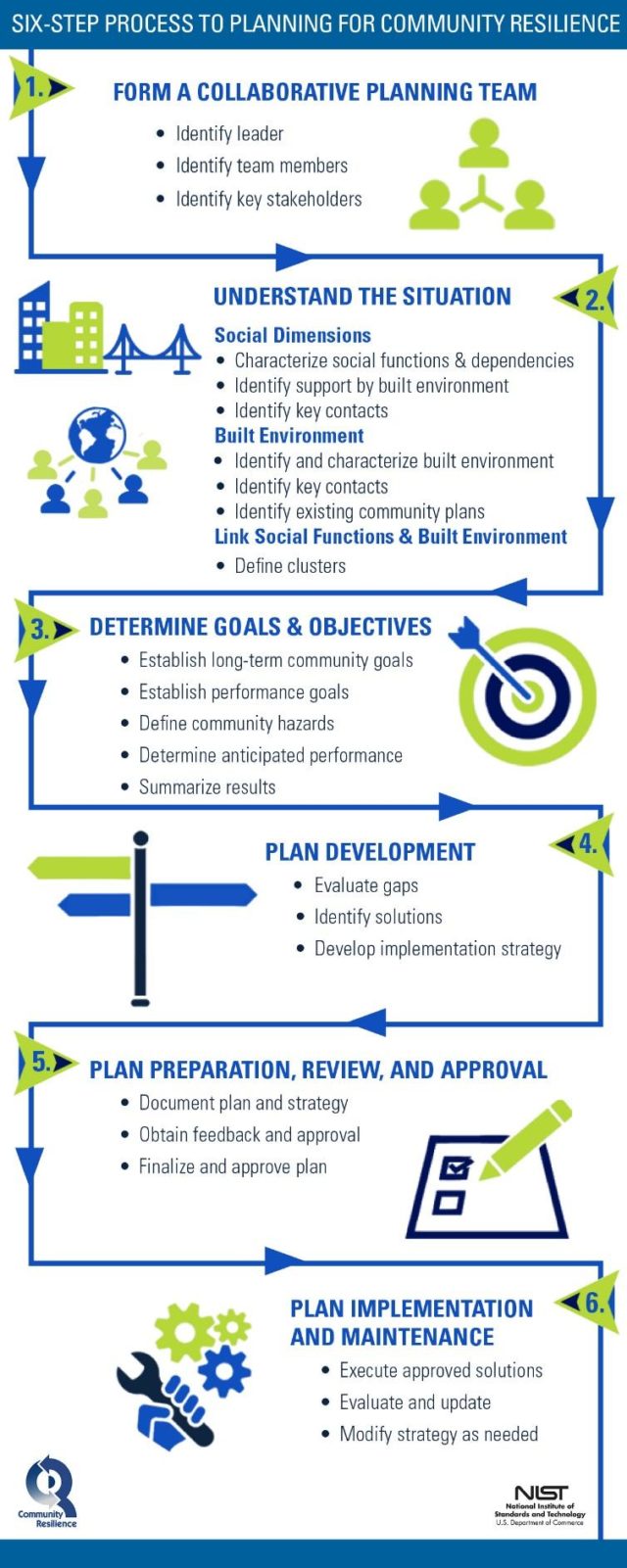
Embracing Resilience: Collaborative and Equitable Resilience Practices
October 1, 2019 — The Big Picture
Community resilience planning is a dynamic process that involves multiple parties with varying interests, issues, and goals. Many communities are developing and implementing resilience plans, however, the needs and challenges vary considerably from place to place. Within the planning process, strong leadership, inclusive collaboration, and decision-making grounded in equity must be given key consideration.
Leadership and Inclusive Collaboration
Resilience planning requires dedicated leadership to facilitate the process, provide continuity, elevate the importance of resilience, convene stakeholders, communicate effectively, and engage with the public. Resilience leadership works with key stakeholders to establish community resilience goals that guide other plans and foster coordination.
Following the 2011 Joplin tornado, the City included residents in long-term recovery planning. One primary community goal was to maintain Joplin’s population. A key tenet of the Joplin planning process: “If your partners and resources are affected by a decision yet don’t have some ownership of it, the likelihood of successful completion diminishes greatly”. Public meetings collected and prioritized ideas for rebuilding and were documented in a report for future funding opportunities.
Input from a broad spectrum of public and private sectors and residents helps develop a comprehensive list of resilience needs and impacts, and engenders community buy-in and support. An inclusive collaboration method that focuses on achieving resilience goals is provided by the NIST Guide and its 6-step process shown in Fig 1. Steps 1 to 3 are essential for developing resilience goals to guide informed decision-making. Step 1, Form a Collaborative Planning Team, ensuring that all community interests and needs are identified. Step 2, Understand the Situation, characterize current performance of social and physical systems for hazard events, as well as dependencies. Step 3, Determine Goals and Objectives, use the information gathered in Steps 1 and 2 to develop community resilience goals.
Nashua is developing their resilience plan using the NIST Guide. Their Collaborative Planning Team includes key stakeholders, such as residents, city staff, businesses, and nonprofits. The Team identified the social functions important to the community and the buildings and infrastructure that support those functions. Data were collected to evaluate the anticipated performance of the buildings and infrastructure for hurricanes, earthquakes, and floods, to identify vulnerabilities. Community goals of desired performance were established with input from community stakeholders.
Community Resilience Equity
As has been observed after disasters, those with fewer resources tend to suffer more damage to their homes and neighborhoods, which may result in dislocation and in broader impacts across the community. Research suggests that low-income populations often suffer disproportionately when disaster strikes, and are more vulnerable to natural disasters due to place and type of residence, building construction, and social exclusion.
Los Angeles’s resilience plan is addressing equity for vulnerable populations by integrating resilience into all community plans and developing indicators for inclusiveness. Their resilience plan acknowledges that “those who are least equipped to handle the effects of catastrophic events end up suffering the most.”
Racial equity is also part of Boston’s resilience plan, which is defined as (1) a shared understanding of how current systems and infrastructure reinforce inequities and (2) fair processes, equal access, and consistent infrastructure quality regardless of demographic status. Focus areas include access to public and private services, employment opportunities, small businesses, housing, and transportation and energy services.
Decision-Making Support for Resilience Goals
Once resilience goals and plans have been established, how should progress be tracked and alternative projects be prioritized? Decision-makers need to consider multiple factors, some that can be measured and some that are more intangible, such as preferences for historic preservation. Two areas where quantitative measures can help inform decision-making are metrics to assess community resilience progress toward goals, and tools to assess the risks and benefits of resilience plans for social and physical systems.
Metrics are often used to track progress toward meeting community resilience goals. However, a National Academies report found that metrics they reviewed have not been validated for measuring changes in community resilience. A core set of validated metrics that are useful to most, if not all, communities will enable better tracking of progress towards resilience goals and learning from other community resilience efforts.
Economic tools, such as a cost-benefit analysis, can help establish project funding priorities. Tools that more fully characterize and prioritize resilience investments beyond direct costs and benefits improve understanding of short and long-term contributions to resilience goals. The EDGe$ tool includes consideration of indirect benefits and co-benefits (e.g. reduction in air and water emissions, increased economic activity).
Moving Forward
Experience demonstrates that leadership, inclusive collaboration, equity, and decision-making support are essential to resilience planning and we’ve found that communities are embracing the process of resilience planning, overall. However, the methods and tools communities need for comprehensive resilience planning and decision-making support needs to be validated and better aligned with resilience needs in order to properly protect our cities and citizens from a variety of shocks and stressors in the future.
